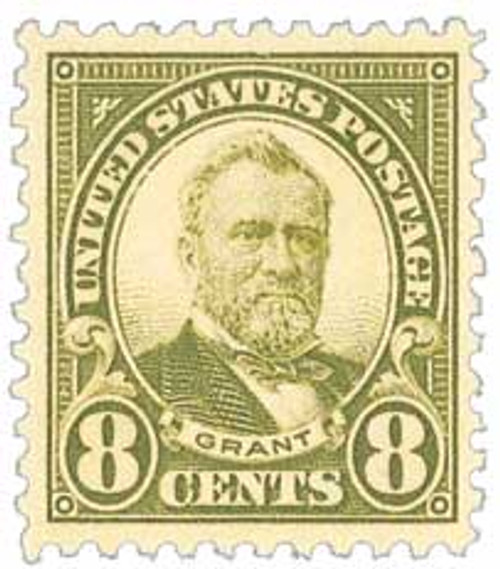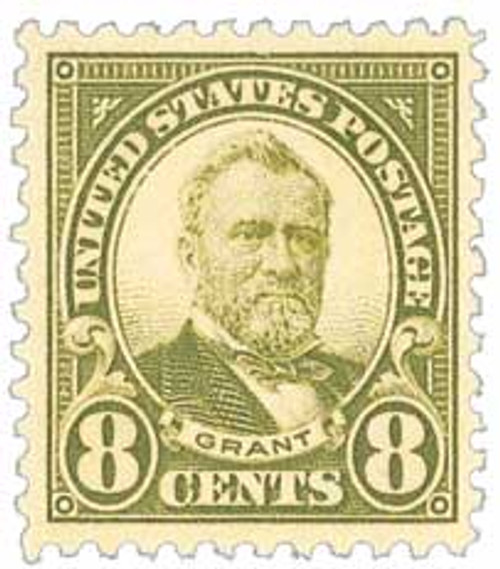
# C4 - 1923 8c Radiator & Propeller, dark green
Airmail
City: Washington, DC, site of the convention
Quantity: 6,414,576
Printed By: Bureau of Engraving and Printing
Printing Method: Flat Plate Printing in sheets of 400, with four panes of 100 per sheet.
Perforations: 11
Color: Dark Green
Transcontinental Airmail

On February 22, 1921, overnight transcontinental airmail service in the US began with flights between San Francisco and New York.
When US airmail service first began in 1918, it was a success, making more money than it spent. However, in the years that followed, it lost money because of increased costs due to a higher number of routes, greater distances traveled, and more mail that weighed down the planes.
Not wanting to charge more for airmail, the post office hoped the government would use tax money to help support the airmail system. However, President Warren G. Harding didn’t believe it was worth it. At the time, transcontinental airmail, a service that began in 1920, was only flown during the day. At night it was transferred to railcars, which carried it to a plane ready to take off at dawn. On its own, a train could cross the country in 108 hours, while this mixture of air and rail took 78 hours. But Harding didn’t believe that decreased time was good enough, arguing that rail mail was cheaper. He stated that he would veto any proposals from Congress to give money to airmail.
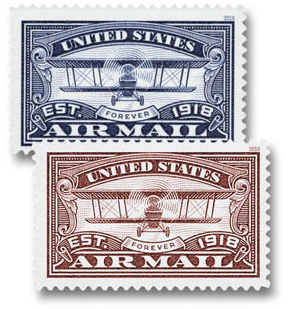
As a result, the postmaster general and his assistant conceived a plan to show how effective airmail could be. They would stage an airmail flight across the country without the use of the railroad. The journey would be much quicker than the current 78 hours and it could prove the effectiveness of airmail to the public and the president. They selected February 22, 1921, George Washington’s birthday, as the day to launch the flight, to gain widespread attention.
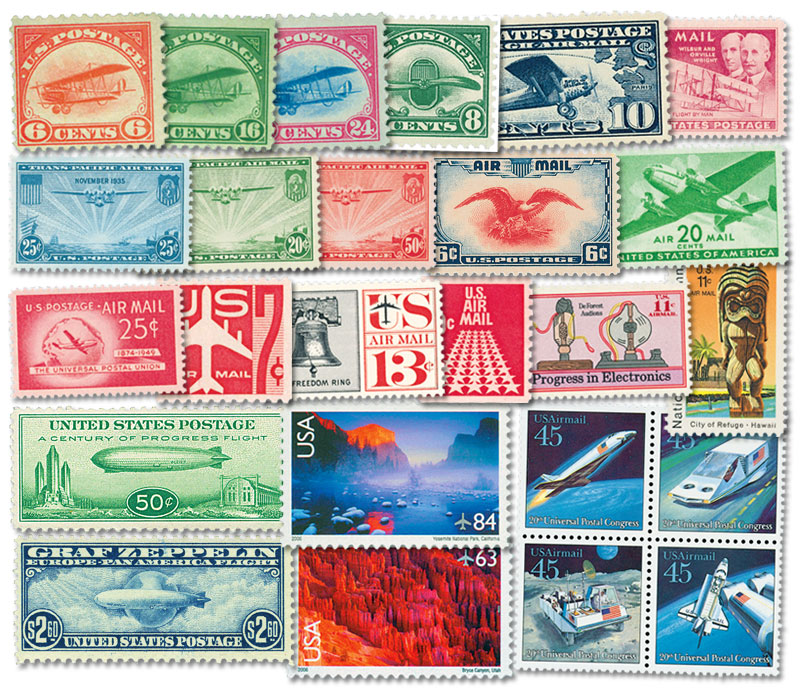
At the time, daytime airmail flights alone were no easy task. Pilots were flying de Havilland DH-4 biplanes left over from World War I. Meant for combat, they weren’t suited for long-range flights and were very uncomfortable. They weren’t fully enclosed, so pilots were exposed to cold and rain, and frequently had to wipe hot oil from the engine off of their goggles.

Plus now there would be the added challenge of flying at night. During the day, pilots used landmarks such as railroad stations or polo fields to stay on course. State road maps only showed towns large enough to host a post office and didn’t mention mountains. Plus the pilots had to fly low, sometimes just 50 feet off the ground, so they could see these landmarks. The assistant postmaster general suggested that postal workers could set strategic bonfires along the route to help the pilots find their way.
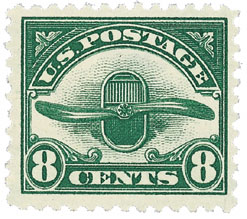
The assistant postmaster general also collected the notes airmail pilots had made of their journeys and combined these with information from local post offices to create the Transcontinental Air Mail Pilot’s Log. This log was the precursor to the modern printed navigation aids.
After extensive planning, the flights westward began at 6:00 a.m. on February 22. Two planes left Hazlehurst Field, Long Island, New York. At 4 a.m. Pacific time, two planes departed Marina Field, San Francisco, California. Along both routes, relay planes would be waiting at pre-determined locations. However, the flights would be plagued with issues. One pilot would lose his life and several of the flights were delayed or canceled due to a massive snowstorm. By 10:44 p.m., James “Jack” Knight was the only pilot still on course.
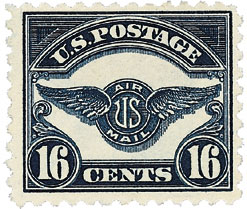
Knight was able to follow bonfires along his route, reaching Omaha, Nebraska at 1:10 a.m. However, once he arrived, he found that his relief pilot was stuck in a snowstorm in Chicago. So he drank a cup of coffee and stuffed newspaper in his jacket for warmth, and departed at 2:00 a.m. Despite the extreme cold and a near crash, he continued on to Chicago, where another pilot took over, finishing the trip and arriving in New York at 4:50 p.m.
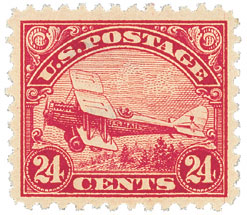
A total of seven pilots had participated in the flight. The whole journey of 2,629 miles took 33 hours, 20 minutes, though 26 hours of that was spent in the air. Despite the setbacks caused by the weather, the public and the president were impressed by the successful flight and President Harding agreed to support a bill to fund the airmail service. The funds provided would help to light airmail routes, create navigational aids, hire pilots, and buy new planes. Airmail service officially began regularly scheduled 24-hour operations on July 1, 1924. With these changes came the creation of three zones to manage routes and price airmail. The zones were New York to Chicago, Chicago to Rock Springs, and Rock Springs to San Francisco. And airmail was set at 8¢ per ounce, per zone.
Click here for more airmail stamps, sets, and covers.
Airmail
City: Washington, DC, site of the convention
Quantity: 6,414,576
Printed By: Bureau of Engraving and Printing
Printing Method: Flat Plate Printing in sheets of 400, with four panes of 100 per sheet.
Perforations: 11
Color: Dark Green
Transcontinental Airmail

On February 22, 1921, overnight transcontinental airmail service in the US began with flights between San Francisco and New York.
When US airmail service first began in 1918, it was a success, making more money than it spent. However, in the years that followed, it lost money because of increased costs due to a higher number of routes, greater distances traveled, and more mail that weighed down the planes.
Not wanting to charge more for airmail, the post office hoped the government would use tax money to help support the airmail system. However, President Warren G. Harding didn’t believe it was worth it. At the time, transcontinental airmail, a service that began in 1920, was only flown during the day. At night it was transferred to railcars, which carried it to a plane ready to take off at dawn. On its own, a train could cross the country in 108 hours, while this mixture of air and rail took 78 hours. But Harding didn’t believe that decreased time was good enough, arguing that rail mail was cheaper. He stated that he would veto any proposals from Congress to give money to airmail.

As a result, the postmaster general and his assistant conceived a plan to show how effective airmail could be. They would stage an airmail flight across the country without the use of the railroad. The journey would be much quicker than the current 78 hours and it could prove the effectiveness of airmail to the public and the president. They selected February 22, 1921, George Washington’s birthday, as the day to launch the flight, to gain widespread attention.

At the time, daytime airmail flights alone were no easy task. Pilots were flying de Havilland DH-4 biplanes left over from World War I. Meant for combat, they weren’t suited for long-range flights and were very uncomfortable. They weren’t fully enclosed, so pilots were exposed to cold and rain, and frequently had to wipe hot oil from the engine off of their goggles.

Plus now there would be the added challenge of flying at night. During the day, pilots used landmarks such as railroad stations or polo fields to stay on course. State road maps only showed towns large enough to host a post office and didn’t mention mountains. Plus the pilots had to fly low, sometimes just 50 feet off the ground, so they could see these landmarks. The assistant postmaster general suggested that postal workers could set strategic bonfires along the route to help the pilots find their way.

The assistant postmaster general also collected the notes airmail pilots had made of their journeys and combined these with information from local post offices to create the Transcontinental Air Mail Pilot’s Log. This log was the precursor to the modern printed navigation aids.
After extensive planning, the flights westward began at 6:00 a.m. on February 22. Two planes left Hazlehurst Field, Long Island, New York. At 4 a.m. Pacific time, two planes departed Marina Field, San Francisco, California. Along both routes, relay planes would be waiting at pre-determined locations. However, the flights would be plagued with issues. One pilot would lose his life and several of the flights were delayed or canceled due to a massive snowstorm. By 10:44 p.m., James “Jack” Knight was the only pilot still on course.

Knight was able to follow bonfires along his route, reaching Omaha, Nebraska at 1:10 a.m. However, once he arrived, he found that his relief pilot was stuck in a snowstorm in Chicago. So he drank a cup of coffee and stuffed newspaper in his jacket for warmth, and departed at 2:00 a.m. Despite the extreme cold and a near crash, he continued on to Chicago, where another pilot took over, finishing the trip and arriving in New York at 4:50 p.m.

A total of seven pilots had participated in the flight. The whole journey of 2,629 miles took 33 hours, 20 minutes, though 26 hours of that was spent in the air. Despite the setbacks caused by the weather, the public and the president were impressed by the successful flight and President Harding agreed to support a bill to fund the airmail service. The funds provided would help to light airmail routes, create navigational aids, hire pilots, and buy new planes. Airmail service officially began regularly scheduled 24-hour operations on July 1, 1924. With these changes came the creation of three zones to manage routes and price airmail. The zones were New York to Chicago, Chicago to Rock Springs, and Rock Springs to San Francisco. And airmail was set at 8¢ per ounce, per zone.
Click here for more airmail stamps, sets, and covers.



















